Are you brave enough to travel with a cello? Victoria Symphony Principal Cello, Brian Yoon, shares the extraordinary steps he takes to fly with his prized cello on Air Canada.
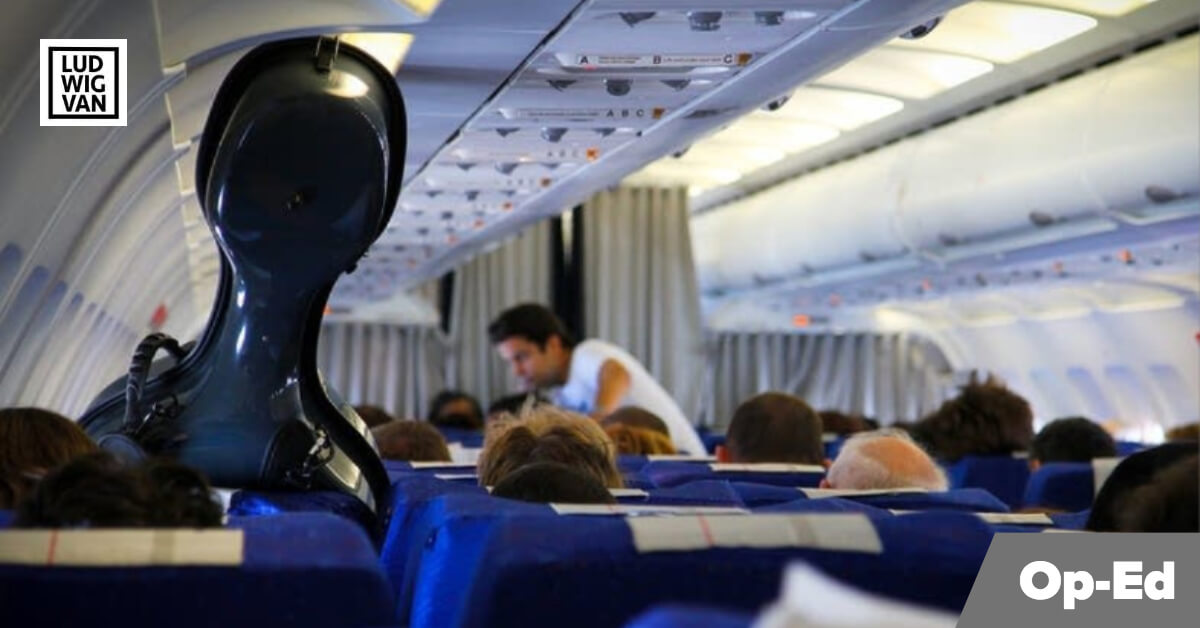
In Canada, there is currently only one major airline that allows an extra seat to be reserved for transporting one’s cello: Air Canada.
After more than 20 successful round trips with a cello as carry-on baggage, Principal Cello at the Victoria Symphony, Brian Yoon, shares his four-stage guide for cellists travelling on flights with Air Canada.
——————
Stage 1: Booking the extra seat
From the Air Canada website:
“You may bring your musical instrument on board as part of your carry-on baggage provided it meets the current Air Canada carry-on size requirements and:
- the instrument fits in the overhead bin or under the seat in front of you, or
- you purchase a seat to accommodate it.
Purchasing a Seat for your Musical Instrument
If you wish to purchase a seat for your musical instrument, you will receive a 50% discount on any published fare (including the lowest available fare) to accommodate the instrument in the same cabin you are travelling in.
Exception: If you are seated in Air Canada Signature Class offering Executive or Classic pods, your musical instrument will, for safety reasons, be placed in Premium Economy or Economy Class.
Also, a few reminders:
- For safety reasons, extra seats may be purchased for musical instruments not exceeding 162.5 cm (64 in.) in height/length or 36 kg (80 lb.) in weight.
- The number of musical instruments that can be accommodated on each flight is limited.
To purchase a seat, or for more information, contact Air Canada Reservations as soon as you’ve booked your flight, or at least 48 hours prior to departure.”
Step-by-step instructions:
1. Book the ticket for yourself on aircanada.com. Do not attempt to reserve the extra seat online at this point. Do not book the ticket on a third-party travel booking site such as Expedia.ca even if you have points you want to use; you will waste hours on the phone if you do.
2. Call Air Canada Reservations at 1-888-247-2262. Give the agent your booking reference code and let him/her know you would like to add an extra seat to your booking. Make sure to confirm the extra seat should be added to every leg of the itinerary. You may be placed on hold at this point, and inexperienced agents may need to ask their supervisor for assistance. Eventually, the agent will say the request has been submitted to the Rates Department, and someone will call you back to collect payment.
3. An agent from the Rates Department will call you within 24-48 hours (but sometimes as little as 30 minutes) with the cost of the extra seat, which should be 50% of the air transportation charges, plus GST. If the agent says you need to pay additional fees for advance seat reservation, politely say you are okay being seated apart from the cello (we will deal with this during check-in). If the agent is aggressive about the advance seat selection fee, do not argue: it’s not worth it. Pay for the seat by confirming your credit card information. You will receive an email confirmation, and the passenger name will usually look like this: “[First name] Mr. Cbbg [Last name].” The exact spacing/capitalization is not important. You have now booked the extra seat for your cello.
Stage 2: Checking-in at the airport
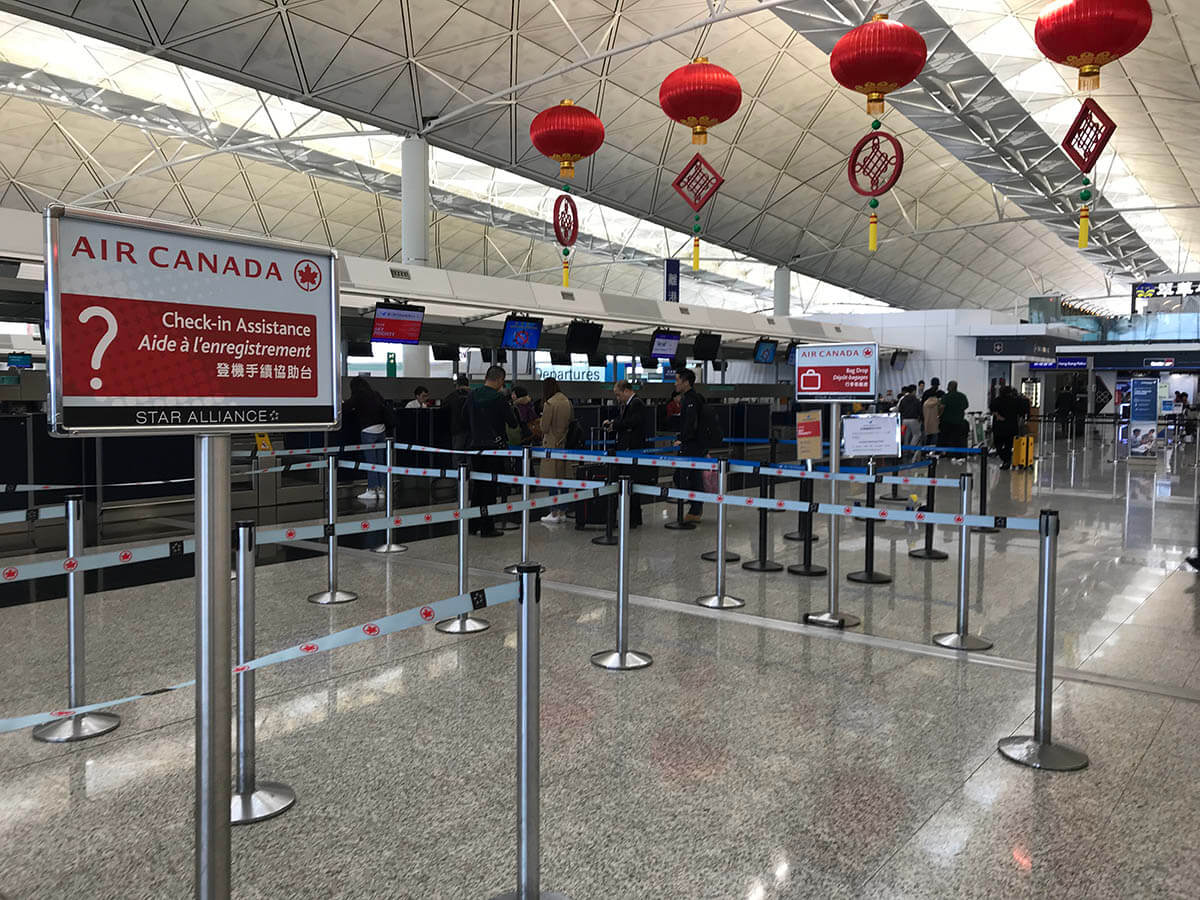
1. Arrive extra early: 90 minutes for domestic flights, 120 minutes for international flights (incl. to/from the US).
2. You will not be able to check-in online or use the self-serve kiosks at the airport. Go directly to the Check-in Assistance counter and the agent will check you in. Notify the agent of the extra seat reserved for your cello so he/she can call the agents at the gate to confirm. Ask to be seated with the cello. You will receive one Boarding Pass for each flight, with “CBBG” in the Remarks/Observations section on the right.
3. Go through security screening. The cello case can be placed directly on most X-ray machines. If this is not possible, the agents may have to take the cello across to the other side; let them know you would like to be present when they inspect the cello. The endpin can sometimes create issues; if you have checked baggage, you may consider placing the endpin in there (but there is a risk of the bag not arriving at your final destination). Otherwise, explain that the endpin is a part of the instrument secured without glue, just like the strings, pegs, bridge, etc.
Stage 3: Boarding the plane
1. Be at the gate at least 15 minutes before the Boarding Time stated on the Boarding Pass. Let the gate agent know you are present with the cello. He/she will contact the ground crew to coordinate your boarding. If the agent says the ground crew will take your cello separately to strap it in, politely insist that you must board at the same time as the cello. 95% of the time, you will board before anyone else.
2. Board the plane. The ground crew may be waiting at the bottom of the ramp to go onboard with you, they may already be on the plane, or they may join you on the flight soon after.
3. The cello seat will almost always be next to the window; sometimes, it is the middle of the three centre seats on a larger plane.
Stage 4: “The NET” (the fun begins)
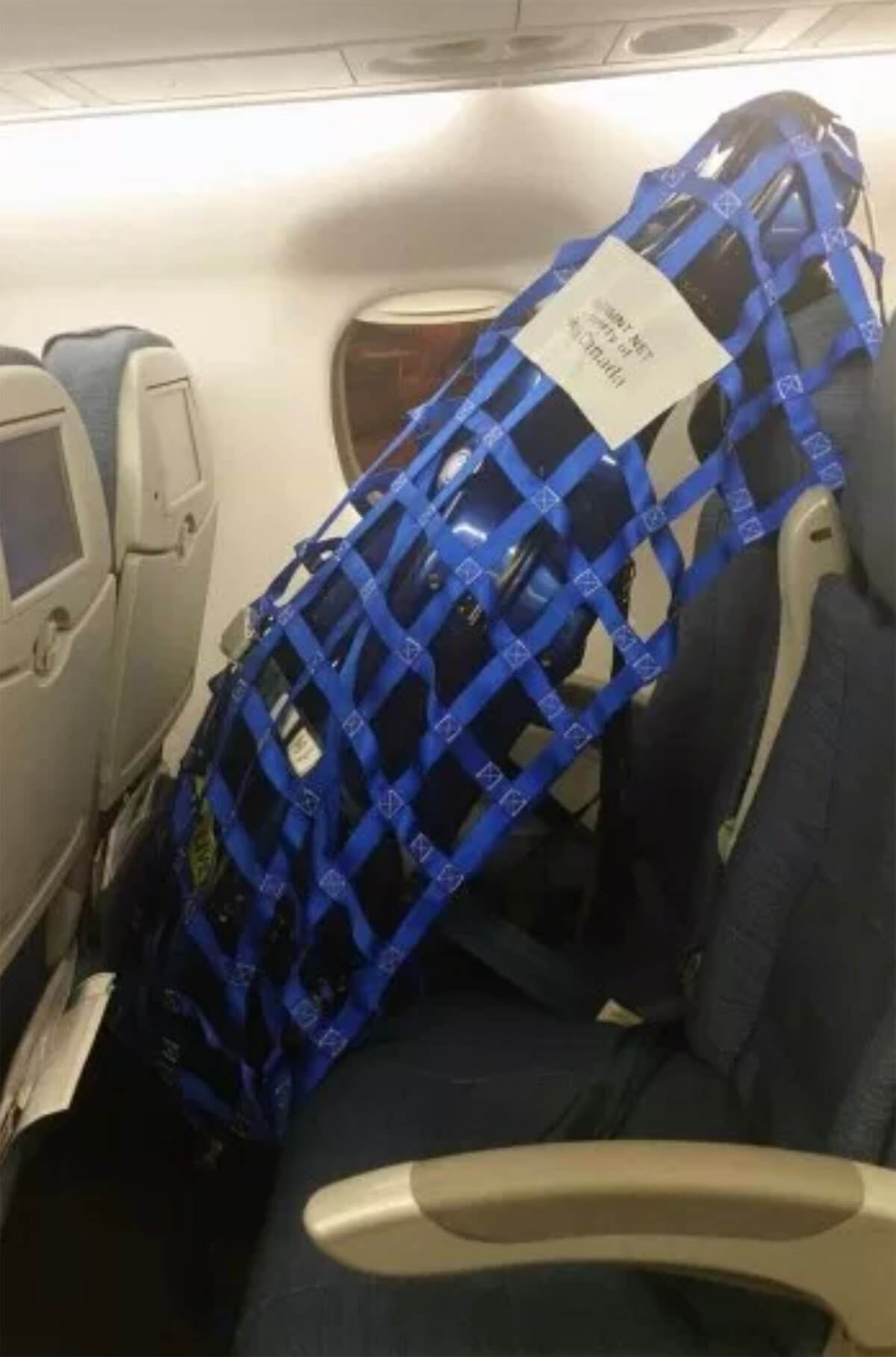
Air Canada is one of the few airlines that requires a net to secure the cello in its seat. (Steven Isserlis on Swissair)
1. Start by taking off the seat cushion, which is secured to the metal frame by velcro, and placing it on the floor
2. Place the cello case upside down, so that the scroll end is resting on the seat cushion on the floor. The bottom end of the case should rest near the top of the seatback. This orientation is important in order to avoid unnecessary pressure on the back of the case against the edge of the seat frame. Excess pressure can fracture the back of a case (see photo). Having the cello right-side-up is also very stressful when the person sitting in front decides to lean the seatback.
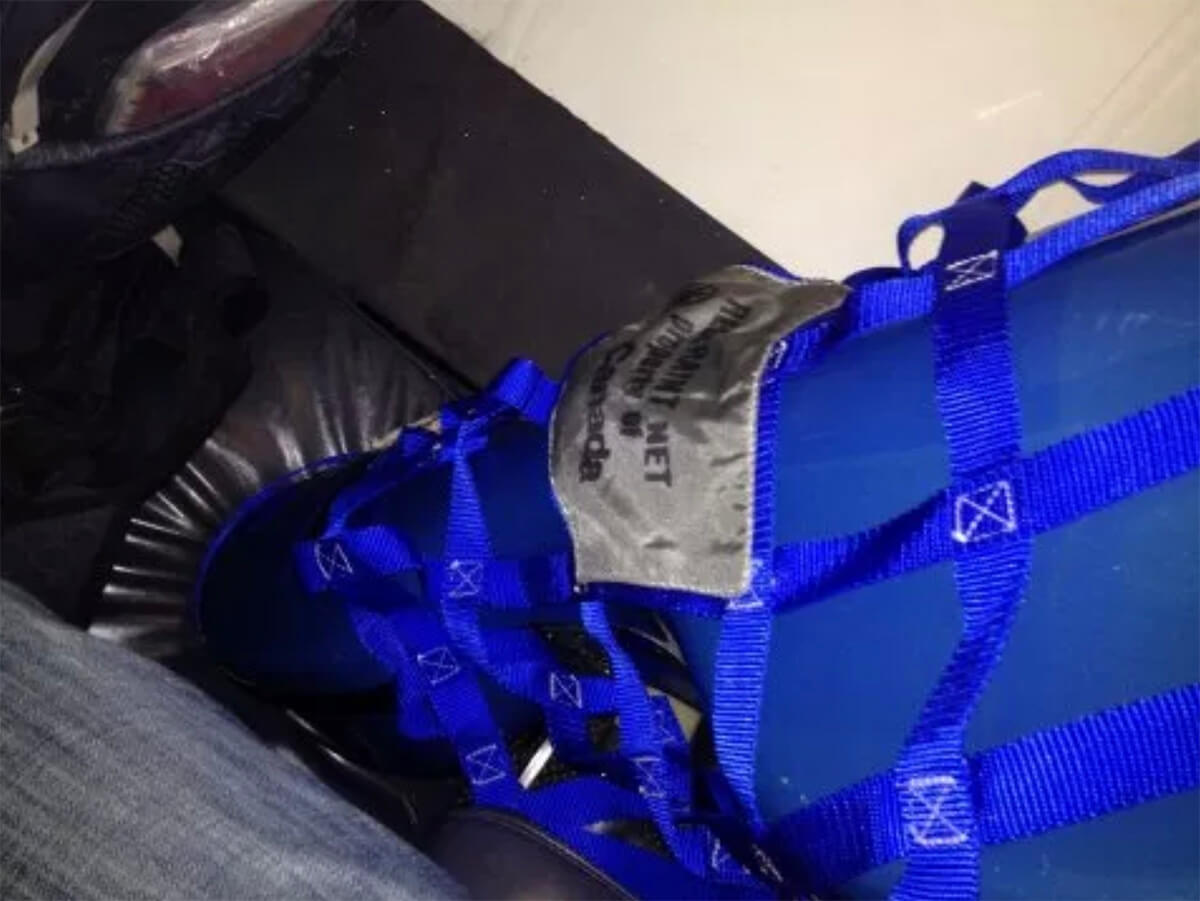
3. With help of the ground crew, unravel the net (usually found at the back of the plane). Release all the hooks (4 total) and extend the straps on the sides (4 attached to the side hooks) and ends (2 attached to hooks and 2 attached to rings).
4. Drape the net as evenly as possible over the cello case. Secure the side hook closest to the window to the ring for securing cabin baggage found on that side of the seat . If there are no rings attached to the seat (very common), secure the hook to the hole in the flat metal piece at the bottom of the seat belt.
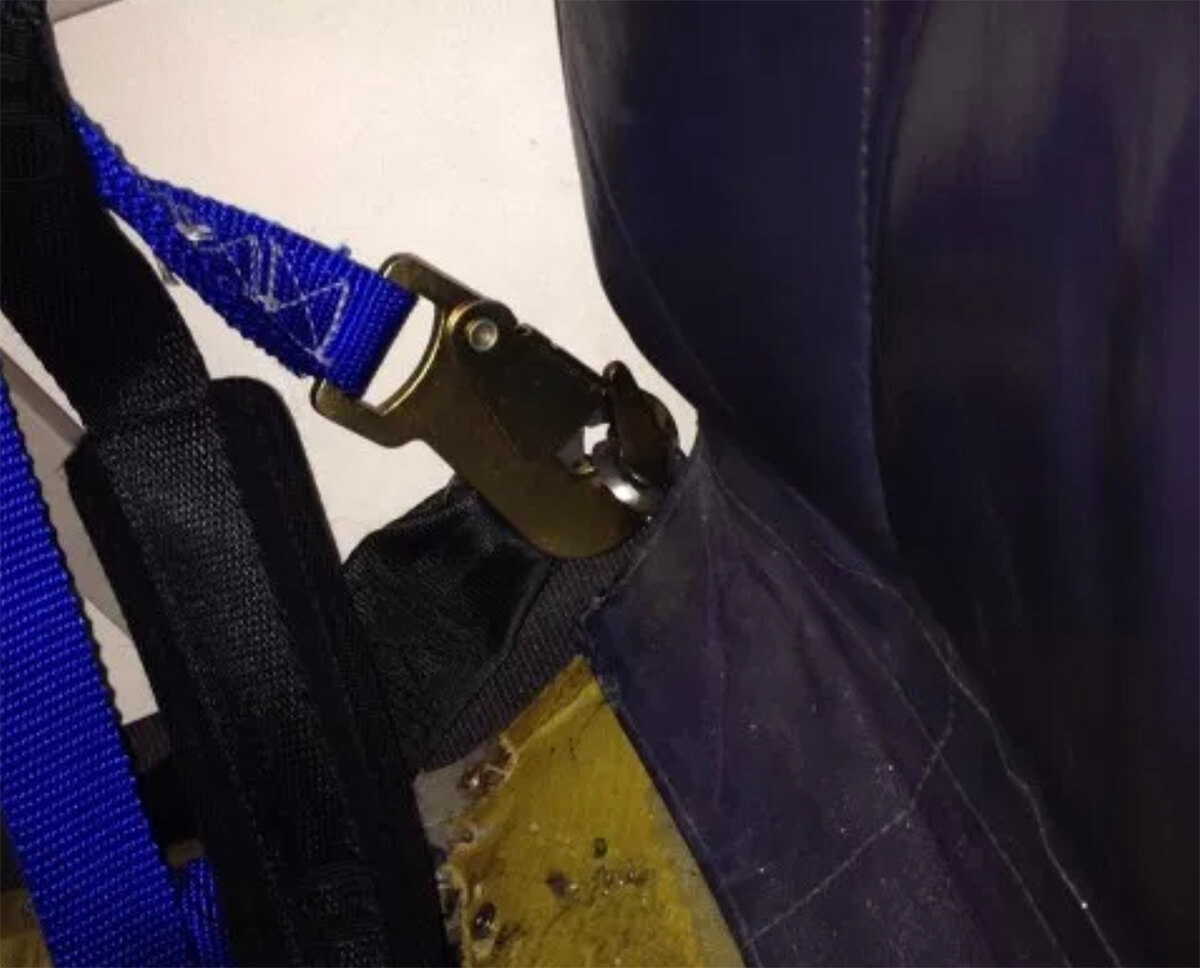
5. Secure the hook on the other side to the cabin baggage ring on the seat, or to the metal piece at the bottom of the seat belt.
6. There should be two straps from the net near the floor; send them back below the seat, on either side of the case.
7. There are two straps near the bottom of the case (now resting high against the seatback). You can do one of two things with these straps: 1. send them through the back edge of the seat (where the seat and back meet) by tearing away the velcro-attached flap; or, if this is not possible, 2. send them back around each side of the seat (not ideal):
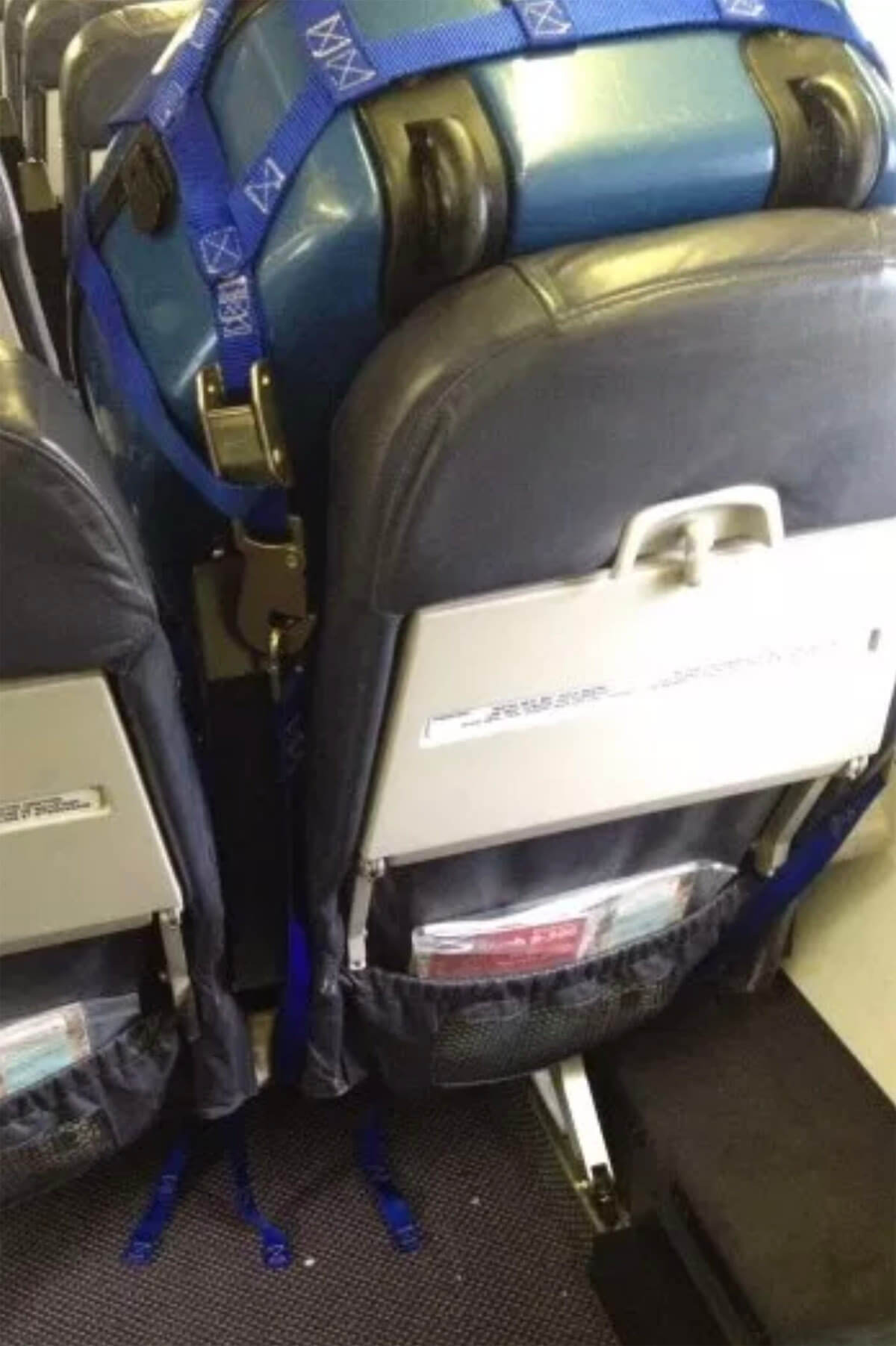
8. Ask one of the ground crew to go behind the seat and connect the straps (now resting loose below the seat) by attaching each hook to the corresponding ring.
9. Pull the straps evenly to tighten the net around the cello. Avoid over-tightening. You are done!
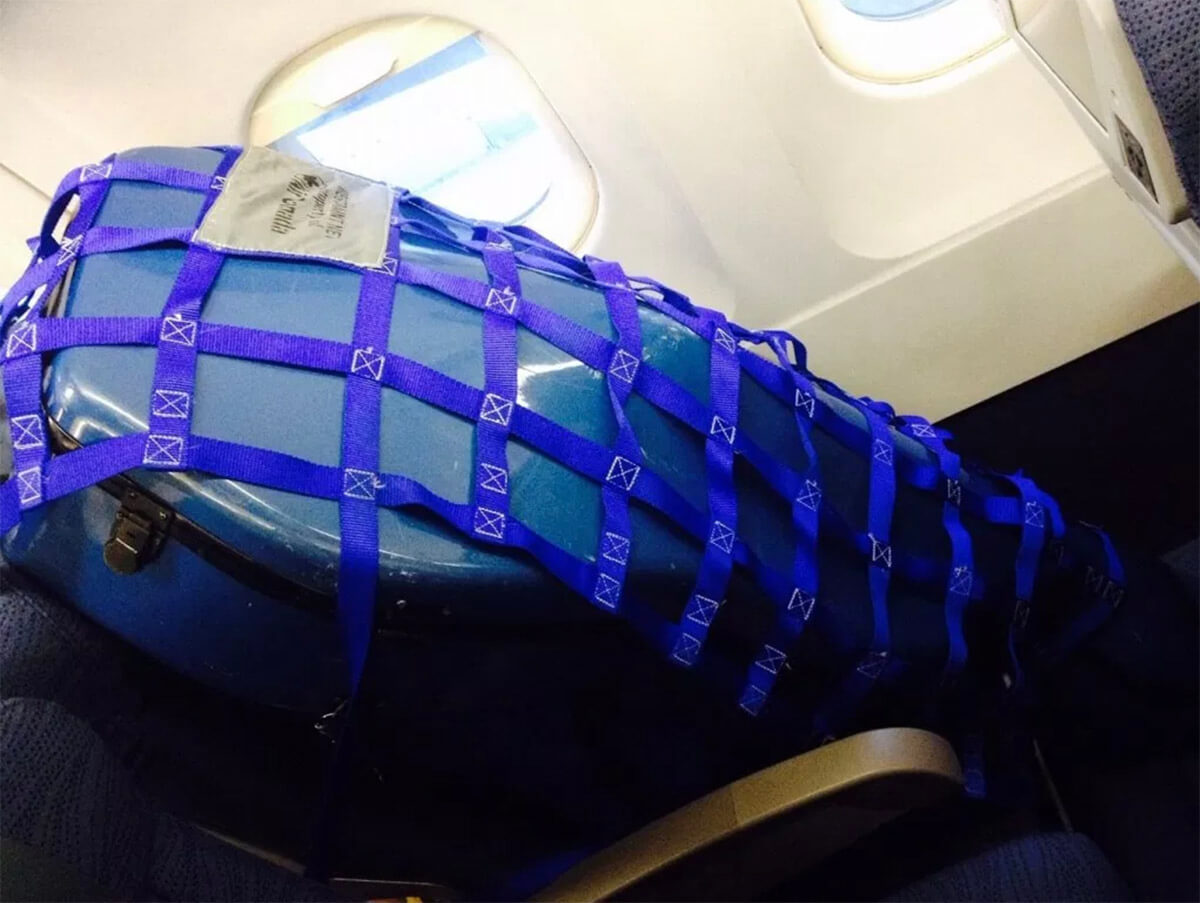
It is important that you direct this procedure as much as possible; most ground crew personnel are not adequately trained in using the restraint net. Fortunately, most people are happy to take your lead to get it done quickly. In cases where the ground crew lead does not want to give you control, monitor the work carefully so that he/she does not lean on the cello or use excessive force. This was Air Canada’s response to damage to the case caused by excessive force in securing my cello in May 2016:
“Thank you for your correspondence. We were sorry to learn of your damaged property.
All air travel is governed by Tariff regulations. These regulations preclude liability for cabin baggage or other items that are considered in the passenger’s own care and control. We would therefore recommend that you discuss this matter with your insurance company as many homeowners and tenant’s packages, as well as many credit cards, provide coverage beyond the airlines’ limitations. If your insurance company requires any additional information or the confirmation that a report has been produced, please ask them to contact us directly. “
(I was eventually reimbursed for the cost of a replacement BAM case, but had to take legal action against Air Canada first. Thanks to AirPassengerRights.ca for their assistance!)
A final note: once in a while, the ground crew person will say that he/she can secure the cello with just a seat belt extension (like most airlines!) and that is sufficient. This is true as far as safety is concerned (to cellists). However, the determination of whether a seat belt extension alone is sufficient is up to the head flight attendant. It is possible that, after the rest of the plane has boarded, the head flight attendant will look up the regulations and ask the ground crew to come on board once again for the net to be installed around your cello. At this point, you should be ready for all eyes to be on you as the captain announces that your cello needs to be adequately secured and the flight is delayed. What you thought was a lucky day could turn into a small nightmare.
Good luck!
+++
This article was originally published on brianyooncello.com
LUDWIG VAN TORONTO
Want more updates on classical music and opera news and reviews? Follow us on Facebook, Instagram, or Twitter for all the latest.



